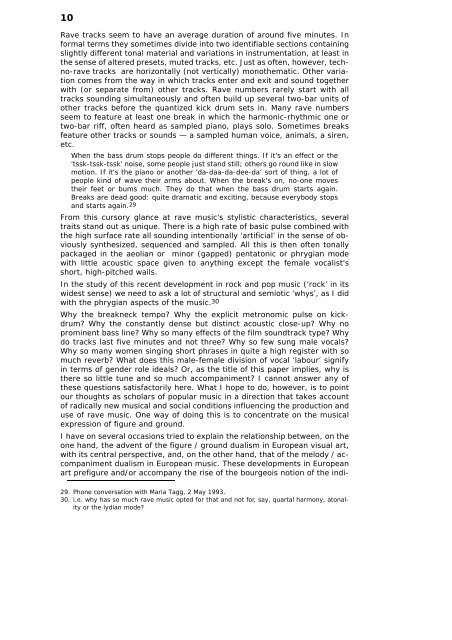From Refrain to Rave - Philip Tagg's home page
From Refrain to Rave - Philip Tagg's home page
From Refrain to Rave - Philip Tagg's home page
You also want an ePaper? Increase the reach of your titles
YUMPU automatically turns print PDFs into web optimized ePapers that Google loves.
10<br />
<strong>Rave</strong> tracks seem <strong>to</strong> have an average duration of around five minutes. In<br />
formal terms they sometimes divide in<strong>to</strong> two identifiable sections containing<br />
slightly different <strong>to</strong>nal material and variations in instrumentation, at least in<br />
the sense of altered presets, muted tracks, etc. Just as often, however, techno-rave<br />
tracks are horizontally (not vertically) monothematic. Other variation<br />
comes from the way in which tracks enter and exit and sound <strong>to</strong>gether<br />
with (or separate from) other tracks. <strong>Rave</strong> numbers rarely start with all<br />
tracks sounding simultaneously and often build up several two-bar units of<br />
other tracks before the quantized kick drum sets in. Many rave numbers<br />
seem <strong>to</strong> feature at least one break in which the harmonic-rhythmic one or<br />
two-bar riff, often heard as sampled piano, plays solo. Sometimes breaks<br />
feature other tracks or sounds — a sampled human voice, animals, a siren,<br />
etc.<br />
When the bass drum s<strong>to</strong>ps people do different things. If it's an effect or the<br />
‘tssk-tssk-tssk’ noise, some people just stand still; others go round like in slow<br />
motion. If it's the piano or another ‘da-daa-da-dee-da’ sort of thing, a lot of<br />
people kind of wave their arms about. When the break's on, no-one moves<br />
their feet or bums much. They do that when the bass drum starts again.<br />
Breaks are dead good: quite dramatic and exciting, because everybody s<strong>to</strong>ps<br />
and starts again. 29<br />
<strong>From</strong> this cursory glance at rave music's stylistic characteristics, several<br />
traits stand out as unique. There is a high rate of basic pulse combined with<br />
the high surface rate all sounding intentionally ‘artificial’ in the sense of obviously<br />
synthesized, sequenced and sampled. All this is then often <strong>to</strong>nally<br />
packaged in the aeolian or minor (gapped) penta<strong>to</strong>nic or phrygian mode<br />
with little acoustic space given <strong>to</strong> anything except the female vocalist's<br />
short, high-pitched wails.<br />
In the study of this recent development in rock and pop music (‘rock’ in its<br />
widest sense) we need <strong>to</strong> ask a lot of structural and semiotic ‘whys’, as I did<br />
with the phrygian aspects of the music. 30<br />
Why the breakneck tempo? Why the explicit metronomic pulse on kickdrum?<br />
Why the constantly dense but distinct acoustic close-up? Why no<br />
prominent bass line? Why so many effects of the film soundtrack type? Why<br />
do tracks last five minutes and not three? Why so few sung male vocals?<br />
Why so many women singing short phrases in quite a high register with so<br />
much reverb? What does this male-female division of vocal ‘labour’ signify<br />
in terms of gender role ideals? Or, as the title of this paper implies, why is<br />
there so little tune and so much accompaniment? I cannot answer any of<br />
these questions satisfac<strong>to</strong>rily here. What I hope <strong>to</strong> do, however, is <strong>to</strong> point<br />
our thoughts as scholars of popular music in a direction that takes account<br />
of radically new musical and social conditions influencing the production and<br />
use of rave music. One way of doing this is <strong>to</strong> concentrate on the musical<br />
expression of figure and ground.<br />
I have on several occasions tried <strong>to</strong> explain the relationship between, on the<br />
one hand, the advent of the figure / ground dualism in European visual art,<br />
with its central perspective, and, on the other hand, that of the melody / accompaniment<br />
dualism in European music. These developments in European<br />
art prefigure and/or accompany the rise of the bourgeois notion of the indi-<br />
29. Phone conversation with Maria Tagg, 2 May 1993.<br />
30. i.e. why has so much rave music opted for that and not for, say, quartal harmony, a<strong>to</strong>nality<br />
or the lydian mode?














